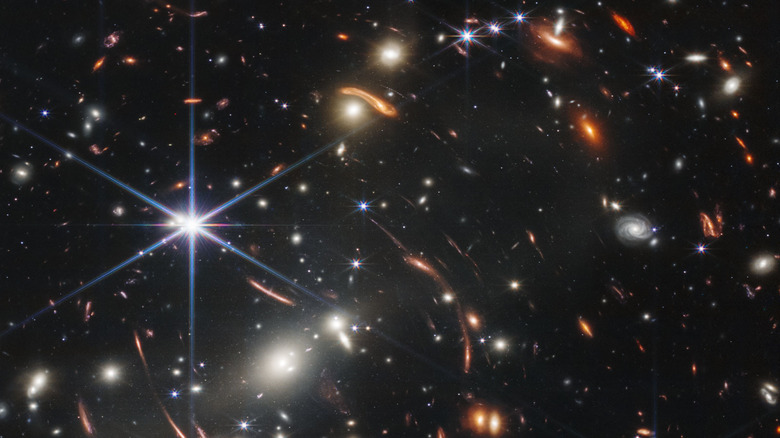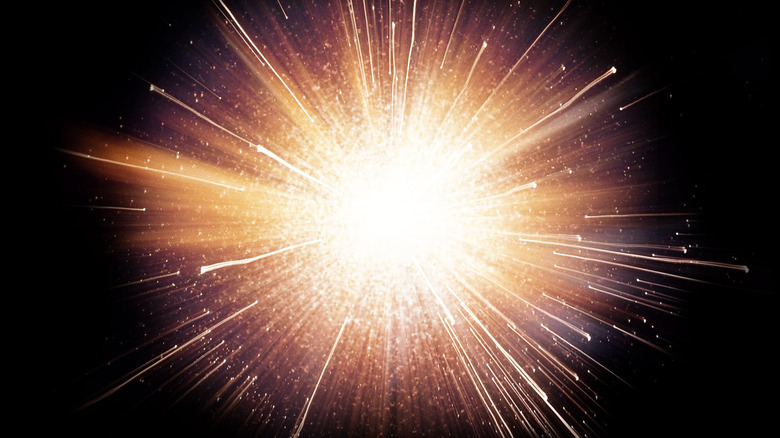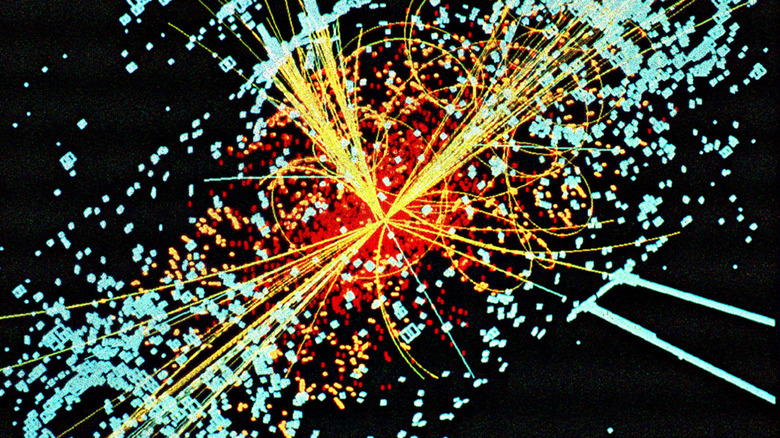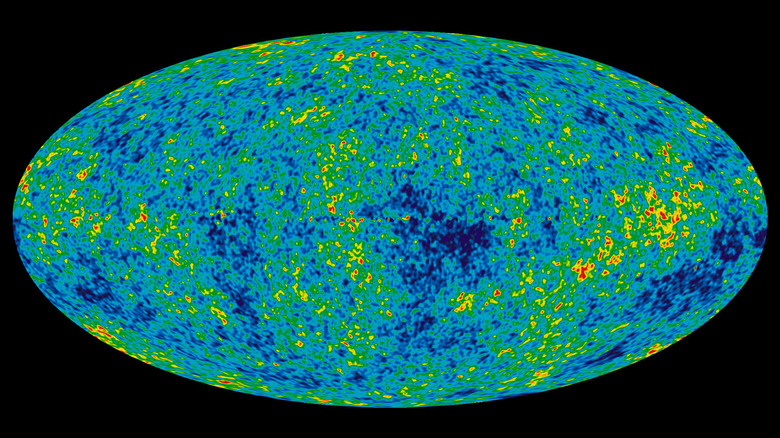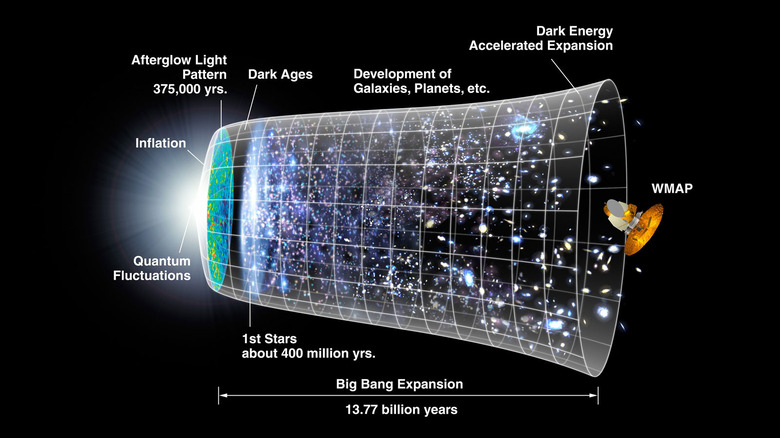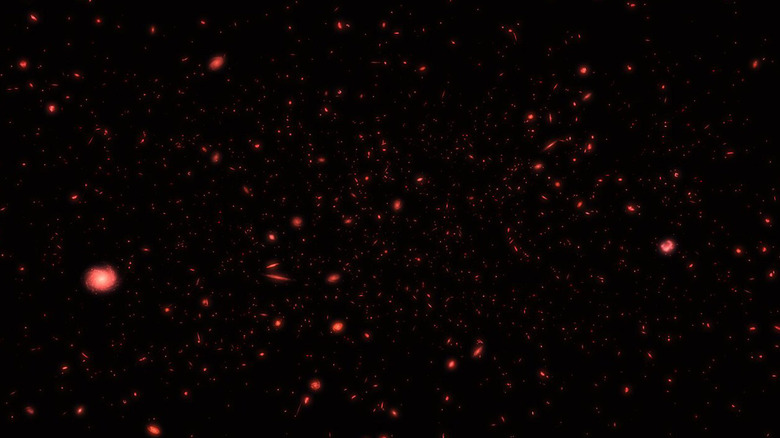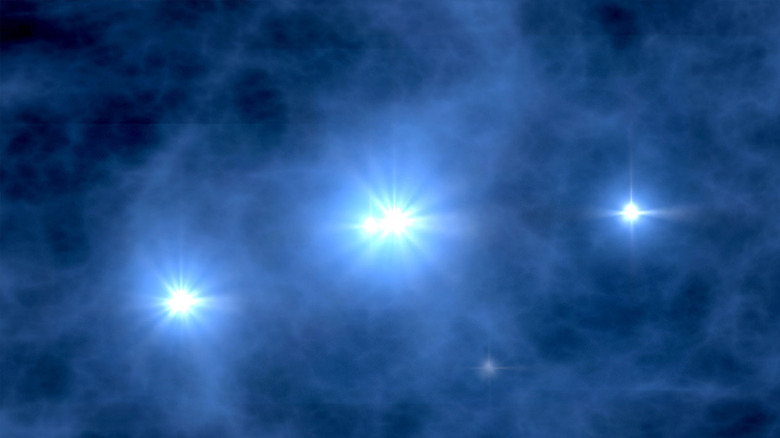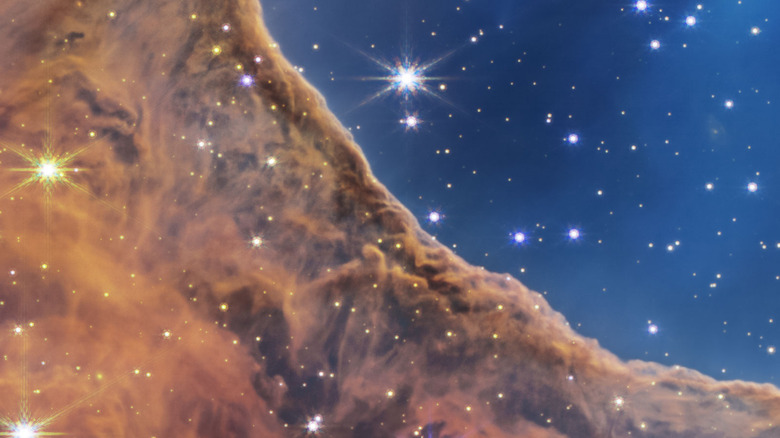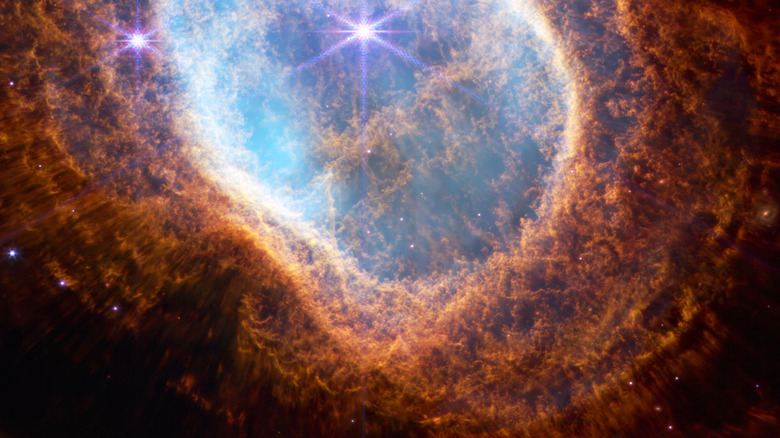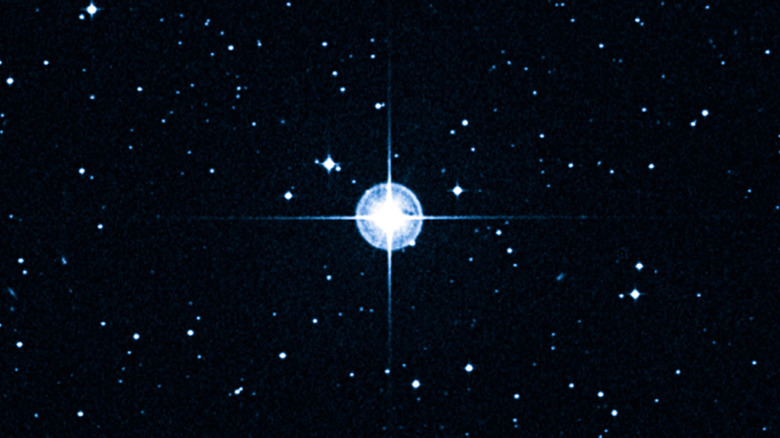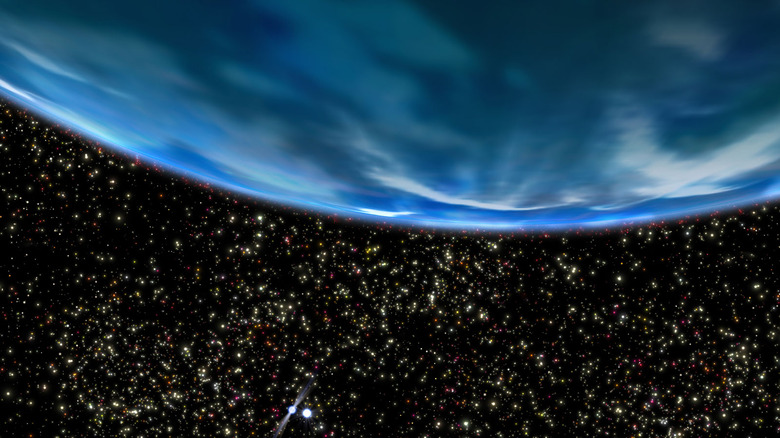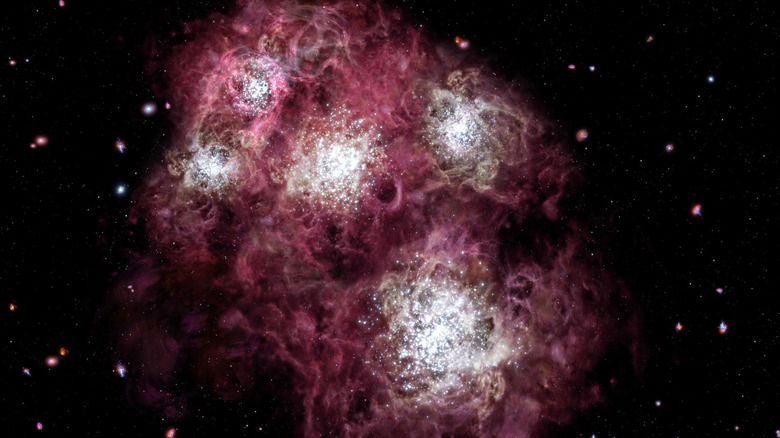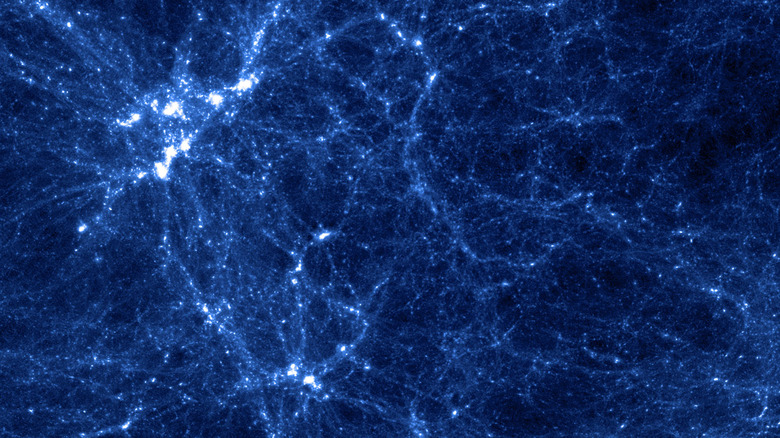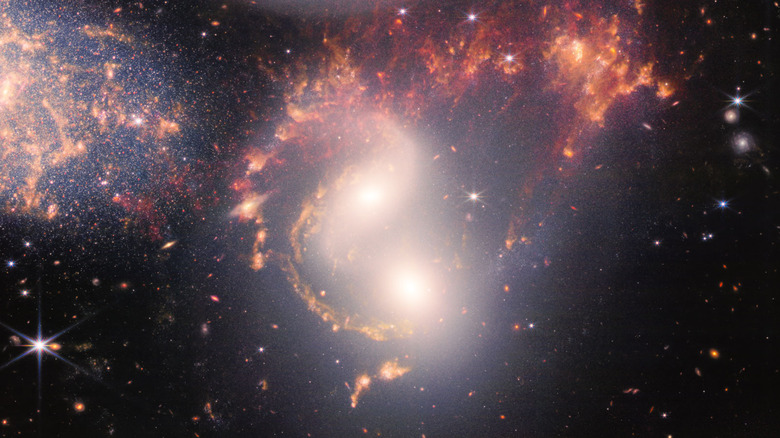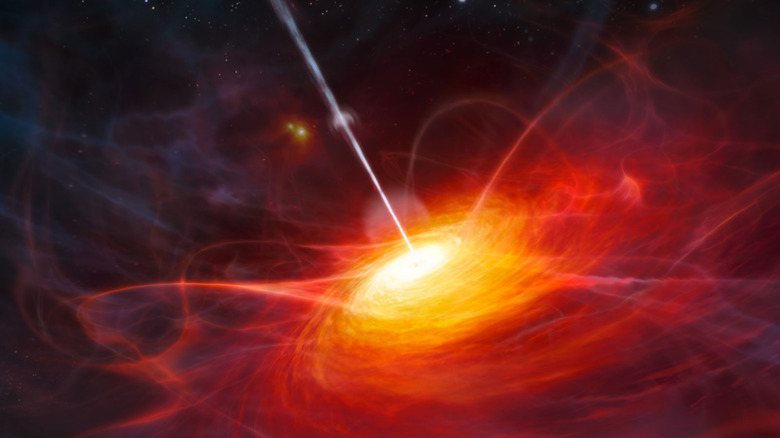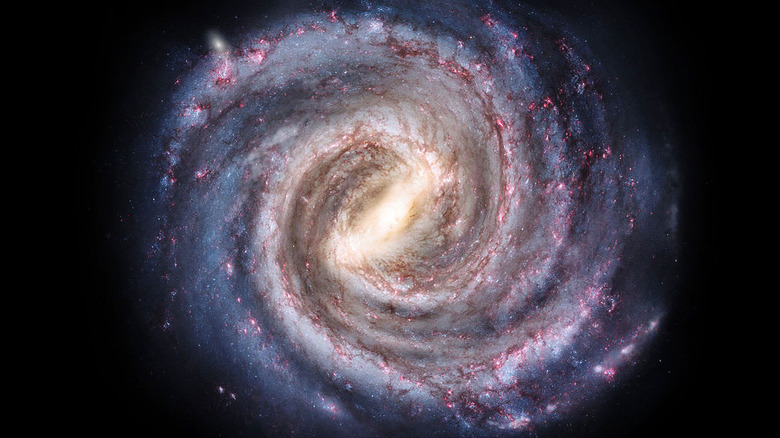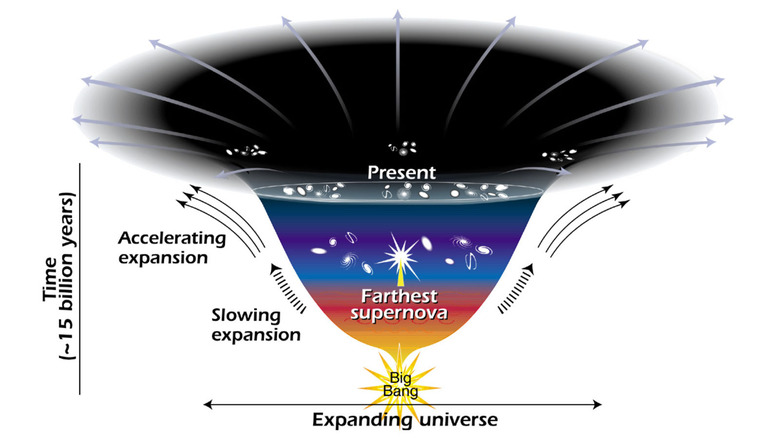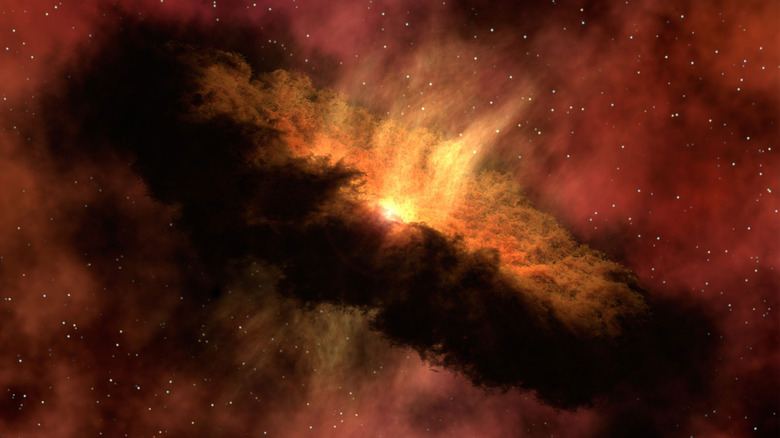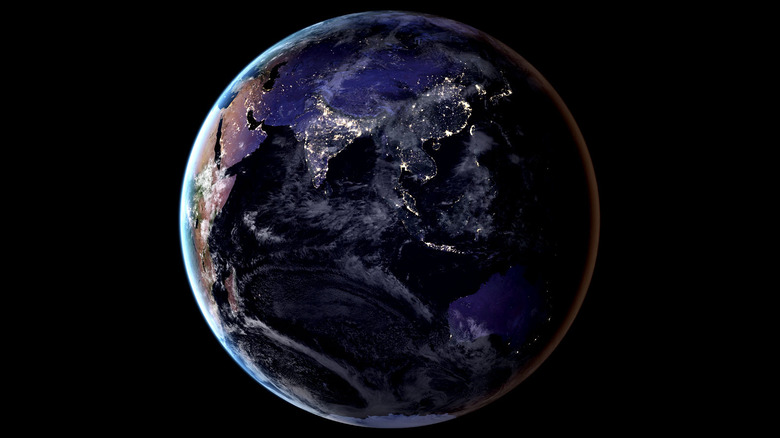Everything We Know About The History Of The Universe
Since its launch in 2021, NASA's Webb Telescope has delivered spectacular images, including the deepest image ever taken of the Universe. As noted by Science, the fine details seen by Webb include a galaxy 13.1 billion years old. Objects this distant may not be visually impressive, appearing in images as little more than fuzzy reddish blobs (nearby galaxies look much more impressive), but they can offer a fascinating glimpse into a time when the entire Universe was still young.
Per Sky At Night Magazine, time and space are intertwined. Light travels at a fixed speed, so images recorded by telescopes like Webb are views of the Universe as it used to be long ago. A more sensitive telescope can see more distant objects, which means further back in time. Being the most powerful telescope ever launched into space, the Webb telescope (also known to astronomers as the JWST) is exceptionally sensitive. New Scientist explains that it can theoretically see things from as early as 100 million years after the Universe was formed.
There's a lot that astronomers still don't fully understand about the history of the Universe, but telescopes like Webb can help to unravel these mysteries, showing details that have never been seen before by human eyes.
The first moments
The entire Universe is, in a sense, an immensely vast and ancient explosion that is still happening to this day. The spark which started it all was the Big Bang, approximately 13.8 billion years ago. As Space.com explains, the Big Bang is our best idea of how the Universe came into being. While there's no way to directly see the Big Bang itself, it's a robust theory, built by scientists over decades.
In the Universe's first moments, a fraction of a second after the Big Bang, everything was contained within a singularity — an infinitesimal point of space, absurdly dense, which contained everything. For the briefest moment after the birth of the cosmos, the Universe existed in a time known as the Planck Epoch. As noted by Astronomy Magazine, this was a fleeting instant in which the entire Universe was compressed so small that space and time held no meaning at all. Then, in under a second, the Universe went through a phase known as cosmic inflation, expanding by an absurd degree so fast it was almost instantaneous.
This newborn Universe still contained little more than an incredibly hot soup of radiation and subatomic particles, lacking any kind of structure or form. Even time itself had barely existed for more than a moment.
Primordial plasma
The primordial Universe started out as a thick and gloopy place. For a few millennia, as the Harvard Center For Astrophysics explains, it was filled with an opaque plasma, a roiling mass of subatomic particles, still too hot to condense into atoms. While the opacity of the early Universe means it's impossible to ever see it as it was back then, these earliest chapters of the history of the Universe are fascinating to cosmologists because they would set the stage for everything still to come.
According to CERN, scientists expect the primordial Universe was filled with both matter and antimatter. Both should have been created in roughly equal amounts. The two then proceeded to annihilate each other, leaving only the relatively tiny amount of matter that remains today in the mostly-empty Universe. The question of why there was more of one than the other is an ongoing mystery, which particle physicists are still investigating.
Eventually, as the Universe cooled, atoms began forming, and then molecules — strange and unfamiliar molecules. According to the Max Planck Insitute, the first molecule to form in the Universe was made from the only two elements to exist at the time, hydrogen and helium. Together, they combined to make a compound called helium hydride. The first chemistry ever, creating a helium compound that seems like it shouldn't even exist.
The cosmos clears
Around the time the Universe reached its 300,000th birthday, it entered an era known as the Recombination Epoch. As explained by Caltech, this happened as atoms began to form — though the word "recombination" is something of a misnomer. This was, after all, the first time anything had ever combined at all. As the Universe cooled enough, matter everywhere began forming into atoms and, as Forbes explains, the Universe became transparent for the first time. This allowed the remaining light from the Big Bang to permeate through the empty space of the cosmos. It has filled the entire Universe ever since.
This ancient afterglow, marking the very edge of the observable Universe, can still be seen today – but not by human eyes. As the Universe continues to expand, the light inside it becomes stretched. This, as Sky At Night Magazine explains, is what astronomers refer to as redshift. The older the light, the more it stretches, fading into red, then infrared, and eventually even longer wavelengths. The primordial light from the birth of the Universe is the most stretched of all. No longer visible to human eyes, as Space.com explains, this light is known as the cosmic microwave background (or CMB for short). It's visible in every direction, as shown in the image here. The mottled appearance shows slight fluctuations, which are imprints left by cosmic inflation. These faint microwaves are the last remaining echoes of the birth of the cosmos.
The cosmic dark ages
As the Universe became filled with atoms, light was finally able to pass freely through open space. However, there wasn't anything in the Universe that could produce any light! This, as EarthSky explains, was a chapter of the Universe known as the Cosmic Dark Ages. There were no stars yet. Just silent and unending inky darkness. The Universe, still in its infancy, was filled with nothing but dark matter with a scattering of neutral hydrogen and helium. But in the darkness, the matter of the Universe was beginning to condense.
Eventually, as the first stars began to form, the Universe entered an era known as the Epoch of Reionization, as the first stars began to flare into life, casting harsh ultraviolet light into the darkness and stripping the electrons from newly formed atoms. However, as Quanta Magazine notes, while stars may have been shining in the Universe for the first time, their light wasn't able to get very far. All of space was still filled with a "fog" of hydrogen gas, blocking out the early light of the first stars. It wouldn't be for some time more until starlight would be able to travel the vast distances it does today.
The early habitable epoch?
By the Earth-centric standards of humanity, any place where liquid water can exist is considered to be habitable. As the early Universe cooled, a fascinating fact is that there must have been a time when the entire Universe was at a habitable temperature. A paper published in the International Journal of Astrobiology refers to this as the Early Habitable Epoch, a deeply speculative idea that asks the question of what might happen in a Universe where life could theoretically exist anywhere at all. According to calculations, this balmy era of the cosmos would have happened when the Universe was still only 10-17 million years old.
Understandably, this idea is a contentious one among scientists. Nature notes one opposing argument that life needs a flow of energy from hot to cold, and that life shouldn't be able to exist in a uniformly warm Universe. Additionally, at such an early age, it's unclear if the Universe would have had stars, planets, or even the oxygen to make water yet. The idea, however, cannot be entirely ruled out. As Hubblesite notes, the first planets probably formed in the first billion years of the Universe. With no way to know for certain, the Early Habitable Epoch is still little more than an interesting thought experiment.
The first lights in the dark
The first stars in the Universe were formed from the pristine material left behind by the Big Bang. As Caltech's Infrared Processing and Analysis Center explains, this first generation of stars was responsible for the first heavy elements in the Universe. These stars, devoid of elements heavier than helium, are known as Population III stars (confusingly, the populations of stars were named in the wrong order). Because stars are effectively the only way for the Universe to produce heavy elements, these Population III stars must have existed at some point. As Scientific American explains, they're expected to have first ignited into existence sometime between 100 million and 250 million years after the Big Bang.
A paper published in Astronomy & Astrophysics discusses the lives these stars must have lived. According to models, they would have been extremely massive and short-lived by the standards of stars in the Universe today. Some may have lasted just 2 million years — a long time from a human perspective, but barely the blink of an eye for a star. When the lives of these first stars reached their ends, they likely exploded violently, possibly as pair-instability supernovae — the most violent kind of stellar explosion the Universe can produce (via Quanta Magazine). However, as Swinburne Astronomy notes, no Population III stars have ever been sighted. With more powerful tools like the Webb Telescope available, perhaps that might change in the future.
The Universe blossoms with stars
We live in a chapter of the Universe known as the Stelliferous Era and, as Astronomy Magazine notes, this era began when stars began to illuminate the darkness. This is, essentially, the modern era of the Universe, when the matter of the cosmos is condensed into stars, planets, and galaxies. The Stelliferous Era is usually considered to have begun around a million years after the Big Bang, and will continue until the Universe is 100 trillion years old. For a length of time many times greater than the current age of the Universe, stars will continue to be born, live, and die throughout the cosmos, fusing hydrogen into heavier elements until all the hydrogen is gone.
While stars are actively forming in the Universe even at this very moment, the stars that fill the sky have ages ranging from newly born to exceptionally old. Stars, after all, can live for billions of years. ABC News even notes that red dwarfs, the smallest and most populous kind of star, live for so long that none have ever died, because the Universe itself isn't old enough yet. Astronomers have spotted some exceptionally old stars lurking out in the cosmos, as National Geographic reports. Some date back to the Milky Way's earliest days, aged between 11 and 13 billion years. Stars like these have seen most of the history of the Universe come and go.
Stars seed the cosmos
By weight, most of Earth is made up of chemical elements heavier than helium, which were forged in the cores of stars. This process, as Science Daily explains, is known as nucleosynthesis. Over the lifetime of a star, nuclear reactions fuse light elements together, making heavier and heavier ones. Forbes elaborates, explaining how elements like carbon, oxygen, silicon, sulfur, and iron are formed abundantly in the hearts of stars. When those stars run out of fuel, they scatter the elements they've made back out into the cosmos.
As stars have been born and died over the last several billion years, they've continually seeded galaxies with elements. As Britannica notes, the elements carbon, oxygen, and nitrogen are among the most abundant elements made by smaller stars. As these stars die, they puff off their outer layers in planetary nebulae, like the Southern Ring Nebula seen by the Webb Telescope. The largest stars end their lives by exploding as supernovae. As a study published by Monthly Notices of the Royal Astronomical Society discusses, these explosions not only fill galaxies with heavy elements like iron, but the shockwaves they cause can trigger a wave of star formation. The death of one massive star can kick-start an entire new generation of stars.
The oldest known star
Hunting for the oldest stars in the Universe is an entire field of astronomy, which can help scientists understand what the early days of the cosmos were like. Possibly the oldest star ever discovered is known only by its catalog number, HD 140283. As NASA explains, this star is so old that the earliest estimates of its age made it appear older than the Universe itself. This effect, however, turned out to be an illusion caused by the uncertainty in making estimates like these. Measuring a star's age, it turns out, is no simple matter.
A later study, published in the journal Astronomy & Astrophysics, gave HD 140283 an estimated age of 13.7 billion years. In other words, it likely formed only a hundred million years after the Big Bang, placing it within one of the first generations of stars ever to be born. This star is "metal-poor," meaning it contains few chemical elements heavier than helium. Known as a Population II star, as explained by Swinburne Astronomy, stars like these are expected to be among the oldest still burning in the Universe today. Determined by the ratios of chemical elements they contain, they're stellar relics: survivors from the earlier days of the Universe.
The oldest known planet
No one knows when the first planets formed, but seemingly they can outlive stars. As Hubblesite explains, the oldest known planet is in orbit around two dead stars, a pulsar and a white dwarf. Stellar corpses like these are the remains of stars that have long run out of fuel and cast most of their chemical elements out into their galaxies. The pulsar goes by a catalog number of PSR B1620-26, and the planet in orbit around it has been affectionately nicknamed Methuselah. It's a massive gas giant planet, not unlike Jupiter.
Methuselah is estimated to be around 12.7 billion years old, but this age isn't exact. There's no good way to tell the age of a planet like this, so the estimate is based on the other stars in its cluster. Globular clusters, like the one Methuselah calls home, are filled with stars all thought to have formed at roughly the same time. According to a study published in the journal Science, the existence of this ancient planet has some interesting implications for when the earliest planets may have formed. If the estimates are correct, and Methuselah really is 12.7 billion years old, it suggests that planets may have been forming earlier than once thought. In other words, Methuselah may not be the only such ancient world lurking in our galaxy.
Galaxies begin to form
When the Universe was around 200 million years old, the first galaxies began forming. As Space.com explains, this discovery was initially a surprise to astronomers, who previously thought galaxies hadn't formed until much later. These early galaxies, as noted by ESA, would have been unlike the huge, spectacular galaxies of the modern Universe. Instead, they would have been formless clouds of gas and dust, still in disarray. Filled with bursts of star formation and brimming with potential, these nascent galaxies were little more than embryos, waiting to grow into the vast galaxies which now fill the cosmos. Our own galaxy, the Milky Way, is thought to have formed around this time too. According to ESO, it probably started forming around 13.6 billion years ago, an unrecognizable blob of stars nothing like the vast spiral it is today.
So far, the oldest galaxy ever discovered dates back to just 300 million years after the Big Bang. As ALMA Observatory explains, this galaxy goes by the name of HD1, and the Webb Telescope will play an important role in confirming its age. If confirmed, HD1 will likely be the oldest galaxy ever seen by astronomers, giving important insights into how the first galaxies formed in our Universe. Galaxy formation is still an active field of study, full of unanswered questions. Helping to answer those questions, NASA says, will be one of the Webb Telescope's main goals.
The large scale structure of the cosmos
The Universe may seem to be mostly an empty void, but it contains an intricate structure on the largest scales. As the Dark Energy Survey explains, the Universe is filled with an array of dark matter filaments, crisscrossing the cosmos to form a web-like mesh. Known simply as Large Scale Structure, this web of dark matter sculpts the way the Universe appears, causing galaxies to form into ordered patterns. The Harvard Center For Astrophysics discusses how the gravity of the Large Scale Structure is what caused matter, both light and dark, to clump together. Studying it is likely to give hints about the Universe when it was still young.
Deep field images, like the first one released by the Webb Telescope, can show how galaxies line themselves up. Known as galaxy filaments, these are the largest visible structures in the Universe, bound into place by nothing more than gravity. What's more, the structures aren't random but have an order to them that astronomers are still actively researching. One study, published in Astronomy & Astrophysics, likens these filaments to pearl necklaces. Entire galaxies and massive galaxy clusters appear to be evenly threaded into galaxy filaments like beads strung onto cords. Like so much about the cosmos, there's still much to learn about the Large Scale Structure.
When galaxies collide
Gravity pulls everything in the Universe together, and the more massive something is, the greater the attraction. Among the most massive things of all are galaxies. The formation and evolution of galaxies is a topic of active research, and the way galaxies evolve is heavily influenced by the way they interact with each other. As the Sloane Digital Sky Survey discusses, galaxies tend to form into groups or clusters, bound together by gravity. When they're in close proximity, they can begin interacting. The gravitational pull of entire galaxies can cause tidal forces, pulling on stars by the billion. In the most dramatic cases, they can even collide, merging in a process that takes billions of years.
Galaxy collisions, explained by PhysOrg, cause a flurry of star formation as the shifting gravitational forces cause disruption on an epic scale. Some stars are flung out into the darkness of intergalactic space, while others are devoured by the supermassive black holes at the hearts of the colliding galaxies. As the galaxies become merged together, their spiral arms are eventually destroyed, as the two galaxies coalesce into a single giant elliptical galaxy. This is probably how some of the largest galaxies in the Universe formed. Other galaxies grow by absorbing smaller galaxies. As New Scientist explains, there's even evidence that the Milky Way has done this in the past, with signs that our galaxy contains the remains of others it long ago devoured.
Supermassive black holes
The largest galaxies, including the Milky Way, contain a supermassive black hole in their core. How these black holes came to be is still an open question, but some appear to be extremely old. ESA shows an image of an ancient galaxy known as UDFj-39546284, appearing as little more than a small ruby-red spot in a larger image. According to "Timelines of Nearly Everything," this humble spot is probably the oldest quasar ever seen by astronomers, appearing around 380 million years after the Big Bang.
Quasars are among the brightest things in the Universe. As Sky and Telescope explains, they're caused by the supermassive black hole at the heart of a galaxy feeding on matter and sending out tremendous amounts of energy. The big question, though, is where these black holes come from. Being seen so early in the Universe makes it a puzzle to explain how they grew to such vast sizes so quickly. One study, published in Nature, has a suggestion. Seemingly, supermassive black holes may have been created cataclysmically, all at once, from turbulent cold gas in the early universe. With the right conditions, black holes may have formed suddenly and violently, collapsing from streams of primordial matter, reaching sizes of up to 40,000 times the mass of the Sun nearly immediately.
The Milky Way's disk forms
The Milky Way is widely agreed to be a spiral galaxy, but this was not always the case. The spiral of a galaxy forms in a galaxy's disk and, per Science Alert, the Milky Way didn't always have a disk. Seemingly, it started to form one around 10 billion years ago. According to ESO, this means that our galaxy spent the first three billion years of its life with no disk, and therefore, no spiral arms.
As a comprehensive paper in Annual Reviews of Astronomy and Astrophysics notes, the disk of a spiral galaxy contains the bulk of the galaxy's matter. In galaxies like these, star formation happens mostly in the spiral arms, as stars condense from the vast clouds of gas and dust slowly orbiting the galaxy's core. How and why galaxies form disks and spiral arms is still not entirely understood by astronomers, even though they're seen abundantly across the sky. Seemingly though, some galactic disks are extremely old. The oldest one seen so far is known as the Wolfe Disk and, as Science News reports, this spiral galaxy is truly ancient, having been observed when the Universe was still only around 1.5 billion years old. Of course, being so far away, there's no way of knowing what it looks like now, or if it still has its spiral shape.
Dark energy takes over
A big turning point in the history of the Universe is, perhaps, a slightly unsettling one. It concerns dark energy, the mysterious force that drives the expansion of the Universe. No one is entirely sure what dark energy is, though astronomers can measure its effects. According to Astronomy Magazine, the Universe has long been engaged in a tug-of-war between the attractive force of gravity and the repulsive force of dark energy. At some point, around 5-6 billion years ago, dark energy began to win. As the Universe continued to expand, dark energy began to overpower gravity, causing the expansion of the Universe to accelerate.
What exactly this means for the future of the Universe is still an open question. Without knowing more about dark energy or how it works, there's simply no way to know. While it seemingly makes up most of the Universe, as NASA explains, the specifics of what exactly dark energy is are still proving to be elusive. One possibility is that it could be an inherent property of space itself. Perhaps, as astrophysicists and cosmologists learn more about the way the Universe works, more answers about dark energy will reveal themselves.
The birth of the Sun
The Sun is around one-third as old as the entire Universe. According to the American Museum of Natural History, it began to form around 4.6 billion years ago. As the Sun formed, the clouds of gas and dust surrounding it began to form into the planets, including Earth, and the Solar System's many moons. All orbiting, spiralling around each other in a gravitationally bound dance.
The Sun, as Swinburne Astronomy notes, is a fairly typical Population I star. Stars like these are the most recent to form in the Universe, enriched with heavy elements like all of those found on Earth. Residing in the disk of the Milky Way, the Sun is one of a vast extended family of stars, most of which are Population I stars. These born from the ashes of the stars that have lived and died before, forging every heavy chemical element in the Solar System, including the elements which make up every human on Earth. It's likely that one of those dead stars may once have even have triggered the formation of the Sun. As Space.com notes, it was very likely the shockwave from a nearby supernova that caused the formation of the Solar System from the vast dust clouds drifting through the Milky Way's disk. The fingerprints of that supernova, in the form of radioactive isotopes, are all over the Solar System. In a sense, that star died so that we could live.
The earliest life
So far, life on Earth is the only known life in the entire Universe. According to the Smithsonian's National Museum of Natural History, life first evolved on Earth around 3.7 billion years ago, not long after the Earth itself finished forming. This means that life has existed for around a quarter of the age of the Universe at least, although the complex life which would eventually evolve into humans is much more recent.
This, however, is only the oldest known life, and there's no way to rule out the possibility that life elsewhere may have evolved much earlier. A Forbes article discusses this in some depth, noting that it's possible that the first rocky planets may have formed in the Universe as early as 300-500 years after the Big Bang. Interestingly though, there would have been one vital ingredient still missing at the time. Carbon. For life on Earth, carbon is essential, and seemingly there wouldn't have been enough carbon available in the cosmos until around 1-1.5 billion years after the Big Bang. As for where life first originated, it's still unknown whether the earliest life in the Universe even needed a planet to live on. For that matter, as Science Daily notes, it's possible that life elsewhere may use very different chemistry, and even elements, to life on Earth.
The thinking Universe
In the words of astronomer Carl Sagan, "we are a way for the Universe to know itself" (via Live Science). Humans are as much a part of the Universe as the most distant star or galaxy, meaning that at least some part of the Universe is able to observe and think. The earliest proto-humans, according to History.com, appeared on Earth around 2.4 million years ago, meaning that humans and our direct ancestors have existed for just 0.02% of the age of the Universe. On a cosmic timescale, we were essentially born yesterday. However, there's a good chance that humans are neither the only nor the first civilization to exist in the Universe.
The question of whether other civilizations exist in the galaxy is an old and deeply compelling one. National Geographic notes that up to half of all sun-like stars may be hospitable to life, meaning there's no shortage of places for life to form and civilization to develop. One study, published in The Astrophysical Journal, suggests that there should be a minimum of 36 communicating alien civilizations in the Milky Way right now, and their estimate is a somewhat conservative one. Other studies, as Forbes notes, estimate many more, perhaps over 42,000. For now, though, there's no way of knowing who else may be out there, or who came first. With telescopes becoming ever more sensitive, perhaps it's only a matter of time until we discover evidence that we're not alone.
